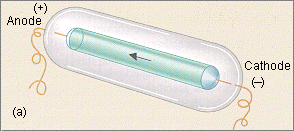Michael Faraday
The Discovery of the
Electron (Michael Faraday)
Many of the early experiments with electricity focused on liquids and solids. By about
1830, Michael Faraday and others had begun to study the effect of an electric current on a
gas. Faraday's apparatus consisted of a pair of metal plates sealed in a glass tube as
shown. The tube was filled with a gas, the metal plates were connected to a series of
batteries, and the gas was slowly pumped out of the tube. Faraday noticed that when
the pressure of the gas in the tube became small enough, the gas began to glow.

|
Cathode-ray
tubes contain a pair of metal plates sealed into a glass tube that has been partially
evacuated. If the residual pressure of the gas is small enough, the glass at the end
of the tube across from the cathode will glow when the tube is connected to a series of
batteries. |

